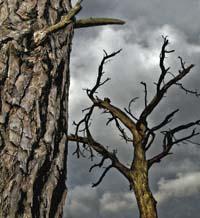Explanation of mass destruction in some plant fossils
2009/06/23 Kortabitarte Egiguren, Irati - Elhuyar Zientzia

Some plant fossils from eastern Greenland show a clear decline in the vegetation of the Jurassic Triassic. According to the researchers, this decline coincides with the increase of carbon dioxide in the atmosphere of the time and with global warming.
In the Jurassic triassic one of the Earth's five massive destructions occurred. Studying the phenomenon observed in plants can help us find the explanation or why of this mass destruction.
Jennifer McElwain and her team analyze six fossil plant groups from the Jurassic Triassic. A decrease has been observed in both the number of plant groups and the number of individual plants during these periods of mass destruction. According to the researchers, the decline in plant diversity coincides with the ability of plants to react and/or respond to abrupt changes in the environment. However, this decline is not a reflection of gradual environmental changes. As initially predicted by the researchers of the time.
Extinction took place in the Jurassic triassic due to the disappearance of marine species and the subsequent appearance of dinosaurs. This observation will help researchers better understand the steps that have led to this transition.
Image courtesy of: Jennifer McElwain

Gai honi buruzko eduki gehiago
Elhuyarrek garatutako teknologia





